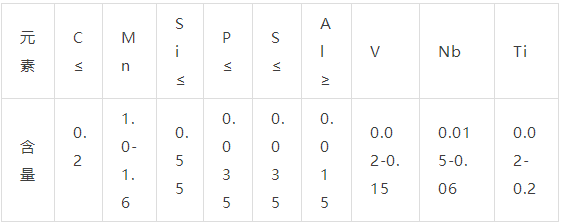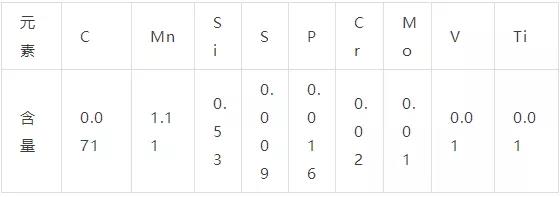Q345A, Q345B, Q345C, Q345D, Q345E steel performance difference?
June 06, 2019
Material | Q345A, Q345B, Q345C, Q345D, Q345E steel performance difference?
Q345 is a material of steel. It is a low alloy steel (C<0.2%) and is widely used in construction, bridges, vehicles, ships, pressure vessels, etc. Q represents the yield strength of this material, and the latter 345 refers to the yield value of this material, around 345 MPa. And the yield value decreases as the thickness of the material increases.
Q345 has good comprehensive mechanical properties, good low temperature performance, good plasticity and weldability. It is used as a medium, low pressure vessel, oil tank, vehicle, crane, mining machinery, power station, bridge and other structures that bear dynamic loads, mechanical parts, building structures, and general Metal structural parts, used in hot-rolled or normalized conditions, can be used in a variety of structures in cold regions below -40 °C.
Level classification
Q345 can be divided into Q345A, Q345B, Q345C, Q345D, Q345E according to the level. What they represent is mainly the difference in temperature of the impact.
Q345A level, is not to do the impact;
Q345B grade is 20 degree normal temperature impact;
Q345C grade, is 0 degree impact;
Q345D grade, is a -20 degree impact;
Q345E grade is a -40 degree impact.
The impact values are also different at different impact temperatures.
chemical composition
Q345A: C ≤ 0.20, Mn ≤ 1.7, Si ≤ 0.55, P ≤ 0.045, S ≤ 0.045, V 0.02 ~ 0.15;
Q345B: C ≤ 0.20, Mn ≤ 1.7, Si ≤ 0.55, P ≤ 0.040, S ≤ 0.040, V 0.02 ~ 0.15;
Q345C: C≤0.20, Mn ≤1.7, Si≤0.55, P≤0.035, S≤0.035, V 0.02~0.15, Al≥0.015;
Q345D: C ≤ 0.20, Mn ≤ 1.7, Si ≤ 0.55, P ≤ 0.030, S ≤ 0.030, V 0.02 ~ 0.15, Al ≥ 0.015;
Q345E: C ≤ 0.20, Mn ≤ 1.7, Si ≤ 0.55, P ≤ 0.025, S ≤ 0.025, V 0.02 ~ 0.15, Al ≥ 0.015;
Comparison 16Mn
Q345 steel is an alternative to the old steel grades of 12MnV, 14MnNb, 18Nb, 16MnRE, 16Mn, etc., and does not replace only one material of 16Mn steel. In terms of chemical composition, 16Mn and Q345 are also different.
More importantly, there is a large difference in the thickness group size of the two steels according to the difference in yield strength, and this will inevitably cause a change in the allowable stress of the material of some thickness. Therefore, it is not appropriate to simply apply the allowable stress of 16Mn steel to Q345 steel, and the allowable stress should be re-determined according to the new steel thickness grouping size.
The proportion of the main constituent elements of Q345 steel is basically the same as that of 16Mn steel. The difference is that the V, Ti and Nb trace alloy elements are added. A small amount of V, Ti, Nb alloy elements can refine the grains, greatly improve the toughness of the steel, and the comprehensive mechanical properties of the steel are greatly improved.
Because of this, the thickness of the steel plate can be made larger. Therefore, the comprehensive mechanical properties of Q345 steel should be better than 16Mn steel, especially its low temperature performance is not available in 16Mn steel. The allowable stress of Q345 steel is slightly higher than that of 16Mn steel.
Performance comparison
Q345D seamless tube mechanical properties:
Tensile strength: 490-675 yield strength: ≥345 Elongation: ≥22
Q345B seamless pipe mechanical properties:
Tensile strength: 490-675 Yield strength: ≥ 345 Elongation: ≥ 21
Q345A seamless tube mechanical properties:
Tensile strength: 490-675 Yield strength: ≥ 345 Elongation: ≥ 21
Q345C seamless pipe mechanical properties:
Tensile strength: 490-675 Yield strength: ≥ 345 Elongation: ≥ 22
Q345E seamless pipe mechanical properties:
Tensile strength: 490-675 yield strength: ≥345 Elongation: ≥22
Product Series
Q345D steel is compared with Q345A, B, C steel. The test temperature of low temperature impact work is low. Good performance. Containing harmful substances P, S is lower than Q345A, B, C.
The market price is higher than Q345A, B, and C.
Q345d definition: 1 consists of Q + number + quality level symbol + deoxygenation method symbol. Its steel number is "Q", which represents the yield point of the steel, and the latter number represents the value of the yield point. The unit is MPa. For example, Q235 represents a carbon structural steel with a yield point (σs) of 235 MPa.
2 If necessary, the symbol of the quality grade and deoxidation method can be marked after the steel number. The quality level symbols are A, B, C, and D, respectively.
Deoxidation method symbol: F indicates boiling steel; b indicates semi-killed steel: Z indicates killed steel; TZ indicates special killed steel, and killed steel may not be marked, that is, Z and TZ may not be marked. For example, Q235-AF represents Class A boiling steel.
3 Special-purpose carbon steels, such as bridge steel and marine steel, basically use the expression method of carbon structural steel, but the letters indicating the use are added at the end of the steel number.
Q345 (low alloy high strength steel) online excerpt related information
Material introduction
1. The chemical composition of Q345 is as follows (%):

2. The mechanical properties of Q345C are as follows (%):

Where the wall thickness is between 16-35mm, σs ≥ 325Mpa; when the wall thickness is between 35-50mm, σs ≥ 295Mpa
2.1 Calculation of carbon equivalent (Ceq)
Ceq=C+Mn/6+Ni/15+Cu/15+Cr/5+Mo/5+V/5
Calculating Ceq=0.49%, greater than 0.45%, it can be seen that the welding performance of Q345 steel is not very good, and it is necessary to establish strict process measures during welding.
2.2 Q345 steel is prone to problems during welding
2.2.1 Hardening tendency of heat affected zone
In the welding cooling process of Q345 steel, the quenched structure-martensite is easily formed in the heat-affected zone, so that the hardness of the near-slit zone is improved and the plasticity is decreased. As a result, cracks occur after welding.
2.2.2 Cold crack sensitivity
The welding crack of Q345 steel is mainly cold crack.
Welding construction process
Groove preparation → point solid welding → preheating → inner mouth welding → back root cleaning (carbon arc gouging) → outer port welding → inner mouth welding → self-test / special inspection → post-weld heat treatment → non-destructive inspection (welding Seam quality level 1)
Selection of welding process parameters
Through the analysis of the weldability of Q345 steel, the measures are as follows:
1. Selection of welding materials
Due to the large tendency of cold cracking of Q345 steel, the low-hydrogen type welding material should be selected, and the E5015 (J507) type welding electrode should be selected considering the principle that the welded joint should be stronger than the base metal.
The chemical composition is shown in the following table (%):
 The mechanical properties are shown in the following table:
The mechanical properties are shown in the following table:
 (The tensile strength should be greater than the yield)
2. Groove form: (according to drawings and equipment)
(The tensile strength should be greater than the yield)
2. Groove form: (according to drawings and equipment)

3. Welding method: manual arc welding (D).

4. Welding current: In order to avoid the coarseness of the weld structure and the impact toughness, it is necessary to use small gauge welding. The specific measures are: selection of small diameter welding rod, narrow bead, thin welding layer, multi-layer multi-pass welding process (welding sequence as shown in Figure 1). The width of the weld bead is not more than 3 times of the welding rod, and the thickness of the weld layer is not more than 5 mm. The first to third layers are made of Ф3.2 welding electrode with a welding current of 100-130A; the fourth to sixth layers are made of Ф4.0 electrode with a welding current of 120-180A.
5. Preheating temperature: Since the Ceq of Q345 steel is >0.45%, preheating should be carried out before welding. The preheating temperature is T0=100-150°C, and the interlayer temperature Ti≤400°C.
6. Post-weld heat treatment parameters: In order to reduce the welding residual stress, reduce the hydrogen content in the weld, improve the metal structure and properties of the weld, heat treatment of the weld after welding. The heat treatment temperature is 600-640 ° C, the constant temperature time is 2 hours (when the thickness is 40 mm), and the temperature rise and fall is 125 ° C / h.










